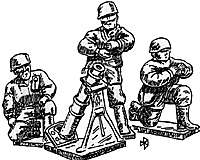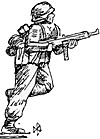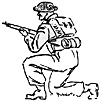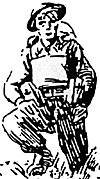 There have been strenuous efforts made recently in the pages of Lone Warrior to reverse an apparent decline in interest in Play by Mail wargames. As I have previously umpired quite a few PBMs myself, I would like to add my endorsement to all that has been said in favour of this method of wargaming.
There have been strenuous efforts made recently in the pages of Lone Warrior to reverse an apparent decline in interest in Play by Mail wargames. As I have previously umpired quite a few PBMs myself, I would like to add my endorsement to all that has been said in favour of this method of wargaming.
I wonder, however, if many SWA members are put off running a PBM by the complexity of the rules, paperwork, record keeping, etc. which appear to be needed in order to successfully run a game with several independent players. I would like to dispel this belief. If you want to run a campaign on this level, fine - they can be great fun, (for the record, my first PBM grew to have 45 players and seriously looked like taking over my life) but it doesn't have to be like this. You can also have great fun with a smaller number of players and minimal record keeping. As an example, one of the last PBMs I ran had just two players. This game earned a certain notoriety, as it not only spawned a convention display game by the local club in Rotherham, but also inspired one of the players, Alan Stretton, to scratchbuild a whole 1940's English town in 20mm! Here are some of the details and extracts of the campaign, hopefully to whet your appetite to try the same sort of thing:
TAMING THE SEALION
 The campaign was set on a fictitious section of the south coast of England in 1940, with a German invasion expected at any moment. The British player assumed the guise of Colonel Roderick Bulstrode (Retired), commander of all the local defence units in the area. The German player was Oberst Werner Voss, ordered to capture a strategic bridge to prevent British reinforcements outflanking the main German assault further to the east.
The campaign was set on a fictitious section of the south coast of England in 1940, with a German invasion expected at any moment. The British player assumed the guise of Colonel Roderick Bulstrode (Retired), commander of all the local defence units in the area. The German player was Oberst Werner Voss, ordered to capture a strategic bridge to prevent British reinforcements outflanking the main German assault further to the east.
Col. Bulstrode had a number of Home Guard platoons, plus a stiffening of regular troops from the Royal West Kents and Royal Engineers. There were also some units in the area over which the good colonel had no control, ranging from an AA battery to a barrage balloon section and an Observer Corps post. I had a great time assigning characters to all the unit leaders, which was done in a completely arbitrary fashion and with no rules whatsoever!
In order to achieve his objective, Oberst Voss was given a choice of the type of troops he could use: fifth columnists, paratroops or a full-scale seaborne assault: he opted for the latter and picked the town of Warmington-on-Sea as the target. The bridge had to be in German hands by 6.00 a.m. on the 14th September. As all the resources of the Wehrmacht were at his disposal, Voss could pick his own landing time and whatever troops he wanted - I only restricted the number and size of landing vessels he was allocated. Also, the large landing barges, suitable to carry tanks, etc., could only discharge their cargoes at the pier, which needed to be repaired first. The Oberst set to work to find the best combination of units for the assault.
Meanwhile, Colonel Bulstrode was frantically trying to arrange his meagre resources into some sort of defence, without knowing from which direction the assault would come. Having allocated his stock of Sticky Bombs and First World War Lewis Guns, he set up his HQ in the Fourways Inn, beside an important crossroads, and began to make 'phone calls and requests to anyone he thought might be able to help. At first these were optimistic: "Try and scrounge a couple of crates of grenades." " Any mines available?" but, with constant refusal, usually followed by the mantra: "There is a war on, you know", these soon settled down to: "Equip all sections with shaving mirrors, for signalling." "Get the sappers to build some dummy tanks." "Has anyone got any homing pigeons?"
Both players were only given information that their character would receive either by wireless or telephone reports, or what they could see for themselves. Obviously, in the case of the former, this was often dependant on the reliability of the informant:
"Hello Sir, Captain Square here, Eastgate Home Guard. My chaps have brought in a suspicious character; a stranger. He speaks English, but with a strange accent. He says he doesn't know who he is and his clothes are odd; ill-fitting and old. No Sir, no ration books or ID card. What shall we do?" (This shipwrecked, shell-shocked Newcastle seaman was placed under heavy armed guard and only narrowly escaped being shot as a spy.)
At last, at 8:15 p.m. on the 13th September, Colonel Bulstrode received an urgent telephone call:
"Colonel? Mainwaring here, at Warmington. We're under fire, sir, from the sea. Yes, very heavy. I..damn!....No, I'm still here. Most of my chaps are under cover and we've made sure the civilians are in the shelters. I think this is it, Sir, the invasion. I'll keep you informed."
But...
"Square here. No, nothing happening at all, Sir. It will be that fool Mainwaring, frightened of shadows. Besides, who would invade on a night like this? It's raining cats and dogs."
 "Second Lieutenant G-Grimes here, Sir, at the b-balloon barrage. T-trouble? No, I don't think so. At least, I'm sure someone would have told me, wouldn't they?"
"Second Lieutenant G-Grimes here, Sir, at the b-balloon barrage. T-trouble? No, I don't think so. At least, I'm sure someone would have told me, wouldn't they?"
Bulstrode was forced to make a decision. Was this the invasion? Or was it a diversion? Or just a mistake. At 10 p.m., telephone contact with Warmington was lost. The Colonel immediately contacted all his units and had them converge on various locations to the north or east of the town, using whatever transport they could requisition.
Meanwhile, things were not going according to plan for Oberst Voss, newly landed on Warmington beach with his third wave. The leader of his spearhead platoon, Lieutenant Georg, reported that the commander of the assault wave was missing, as were the all-important engineers. ( A simple throw of 2 D10 for each boat; red counting map inches to the left of intended landing point, black counting right.) Also, one landing barge had broached to and spilled out its cargo; the men were soaked but unhurt, but all their equipment was lost. Resistance was fairly heavy (the Germans happened to have hit the area with the greatest concentration of British regulars) but about half the town was in German hands. As Voss received the report, another officer was carried past, wounded. With his attack bogging down due to confusion and lack of officers, the Oberst was forced to re-organise his troops in the middle of the battle.
At 1:30 a.m., the vicar of Warmington pulled up outside Bulstrode's HQ in his Standard 8, with two Home Guardsmen and a Lewis Gun packed inside. He was on his way home from a whist drive in Eastgate when he nearly ran over them on the coast road. One blurted out his story:
"We were on watch in the old Novelty Rock Emporium. Well dug in, we were; got the place nice and cosy, like. Well, all this firing broke out, from offshore. Giving the old town a right pasting, it was. Mind, none of it came our way, so we stayed put. Then, bold as brass, this boatload of Jerries landed right in front of us! I was going to shout to them, tell them to surrender or something, but Bill here says: "Let 'em 'ave it, Harry!" So I did! Went down like ninepins, they did! How many? Oh, twenty maybe, or a couple of dozen. (There were eight, including the missing company commander.) After a bit, we could hear the fighting in the town move round behind us. I wanted to stay put, but Bill says: "We going to be surrounded if we're not careful." So we took up the gun and legged it. That's when we ran into the vicar. Did we do right, Sir?"
Bulstrode was now certain that this was the invasion, but having set the majority of his troops moving, he was having trouble contacting them, all communication being by telephone or runner. Leaving his signaller to pass what information he did have to higher authority, the Colonel took his car to see what was happening for himself. He headed towards the coast road linking Warmington to Eastgate.
By 2:00 a.m., things were looking brighter for Oberst Voss. British resistance in Warmington had ceased and the engineers had finally returned to the fold, having spent ages by-passing one of the dummy tanks. They were set immediately to work to make the pier suitable to disembark the German vehicles. However, Voss was about to make a serious error. He had seen a number of large metal pylons on the hill overlooking the town (an unfinished, non-operational RDF station) and, despite the urgency of his objective, to take the bridge, he decided to split his force. He would send part up the hill towards the pylons, part to the east to outflank the hill and the remainder up the road the north, towards the objective. By 2:45 he had some armoured cars ashore and began his attacks.
Uncannily, despite the British being extremely thinly spread, the Germans always managed to hit the point where the defences were strongest. The attack up the hill became embroiled with a heavy AA battery which, despite its unfamiliarity with engaging ground targets, acquitted itself well against the light German armour.
Colonel Bulstrode set up a new HQ, next to the telephone in another pub (a pattern does seem to be developing) on the coast road. He was in time to witness the German eastern attack, which was held (barely) in the sparse woodland. He then received a message from Sergeant Garbutt of the Bramley End Home Guard:
"Enemy attack increasing in intensity. There are tanks in evidence - so far using only MGs. Casualties are mounting. Please help."
The problem was, Bulstrode did not know how old this message was; the fighting was in woods north of Warmington, and the sergeant had cycled back to Bramley End to find a telephone. By now, the Germans might have overrun the position. Should he despatch some troops from this part of the battlefield to help? Or were they more use here? The Colonel decided to cross his fingers and leave his dispositions as they were.
Oberst Voss was becoming desperate. Reinforcements were being thrown into the fight as soon as they were ashore, but they were being distributed piecemeal between the three separate attacks. Radio reports from the northern and eastern attacks told of steady but slow progress; the German troops, though better equipped and fitter than their opponents, were a finite resource and casualties were mounting.
 Then, from the central attack, up the hill, came the following from Lieutenant Gruber, commanding a troop of light armoured cars:
Then, from the central attack, up the hill, came the following from Lieutenant Gruber, commanding a troop of light armoured cars:
"Yes, Herr Oberst. Our infantry are advancing from hedge to hedge as we clear them with our cannon. We can hear heavy fighting from the east. I...(An explosion) Himmel! That was my No.2! He has brewed up! I don't know where -" Transmission stopped abruptly.
Oberst Voss could stand it no longer. With the very un-German comment: "If you want a job doing, do it your bloody self!" he clambered into his Kubelwagen (with no radio) and sped off towards the fighting on the hill. The German player, having now imposed upon himself a very narrow point of view, became obsessed with this part of the battle to the exclusion of the others which, starved of reinforcement, gradually petered into stalemate.
The 6:00 a.m. deadline arrived, with the Germans in possession of the hill, but still far short of their real objective, the bridge, over which British reinforcements began to pour. Colonel Bulstrode's command had suffered very heavy casualties, but still held on by the skin of its teeth. I adjudged the campaign a British victory. Only now did the British player find out what the German objective had been! Both players said they had enjoyed the game immensely and were eager to begin another straight away!
The small PBM has much to recommend it. You can go into a great deal more detail than is possible in a game with more players and, as I hope the extracts above show, can go to town on the narrative. I had no trouble maintaining the players' interest in the game - in fact, the returns were often back by the next post!
Taking things to a logical conclusion, it could be deduced that the minimum number of players needed for a successful PBM is ONE. And perhaps the prospect of only dealing with a small number of players would be less daunting for a newcomer to PBM umpiring. So, now you've got no excuse - have a go!
Back to Table of Contents -- Lone Warrior #124
Back to Lone Warrior List of Issues
Back to MagWeb Magazine List
© Copyright 1998 by Solo Wargamers Association.
This article appears in MagWeb (Magazine Web) on the Internet World Wide Web.
Other military history articles and gaming articles are available at http://www.magweb.com
